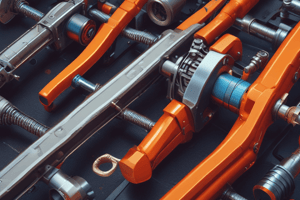Podcast
Questions and Answers
What is physics?
What is physics?
The study of matter and energy and the interaction between the two.
What is a machine?
What is a machine?
A device that makes work easier to do.
What is work?
What is work?
Applying force and using energy to move an object.
What is force?
What is force?
What is effort?
What is effort?
What is a lever?
What is a lever?
What is a load moved by?
What is a load moved by?
What is a pivot or fulcrum?
What is a pivot or fulcrum?
What is a load?
What is a load?
What are the effects that a lever can create?
What are the effects that a lever can create?
What are the three parts of a lever?
What are the three parts of a lever?
What are the three main types of levers?
What are the three main types of levers?
Name seven examples of levers in everyday life.
Name seven examples of levers in everyday life.
Describe a first class lever.
Describe a first class lever.
What is an example of a simple first class lever?
What is an example of a simple first class lever?
What is an example of two connected first class levers?
What is an example of two connected first class levers?
When is a first class lever used?
When is a first class lever used?
When are second-class levers used?
When are second-class levers used?
First class levers are often used to change the direction of what?
First class levers are often used to change the direction of what?
What is an example of a first class lever?
What is an example of a first class lever?
A first class lever can also be connected to each other. Please provide an example.
A first class lever can also be connected to each other. Please provide an example.
What is the third class lever?
What is the third class lever?
Third class levers can be used to do what?
Third class levers can be used to do what?
What is an example of a simple second class lever?
What is an example of a simple second class lever?
What is an example of two connected second class levers?
What is an example of two connected second class levers?
How do you lift a load with the least effort?
How do you lift a load with the least effort?
What is an example of a simple third class lever?
What is an example of a simple third class lever?
What is an example of two connected third class levers?
What is an example of two connected third class levers?
What is the difference between a simple machine and a complex machine? Give an example of each.
What is the difference between a simple machine and a complex machine? Give an example of each.
Explain how to use a first class lever to lift a load.
Explain how to use a first class lever to lift a load.
Flashcards are hidden until you start studying
Study Notes
Physics
- The study of matter and energy, including their interactions.
Machine
- A device designed to make work easier.
Work
- Involves applying force and using energy to move an object.
Force
- A push or pull that instigates motion or change.
Effort
- The force applied to a machine, can be a push or pull.
Lever
- A simple machine that pivots around a fixed point.
- Used to magnify small movements or forces and change force direction.
- Comprises a rod or arm tilting around a pivot.
Load
- The object that is raised or moved by the lever's effort.
Pivot or Fulcrum
- The central point around which a lever rotates.
Effects of a Lever
- Changes force direction.
- Applies force from a distance.
- Increases or amplifies force.
- Enhances movement efficiency.
Parts of a Lever
- Consists of the load, effort, and pivot or fulcrum.
Types of Levers
- Three classes: first, second, and third, distinguished by the arrangement of load, effort, and fulcrum.
Everyday Examples of Levers
- Seesaw, scissors, wheelbarrow, nutcracker, fishing rod, nail clipper, tweezer.
First Class Lever
- Fulcrum is positioned between the effort and the load.
- Example includes a seesaw, facilitating easier load lifting with effort applied away from the fulcrum.
Scissors
- A pair of connected first class levers.
Second Class Lever
- Effort is applied between the fulcrum and the load.
- Primarily used to lift heavy loads or generate substantial force.
- Example: wheelbarrow, also represented in nutcracker pair.
Third Class Lever
- Effort is located between the fulcrum and the load.
- Minimal effort required for large movement, e.g., stapler and fishing rod.
- Tweezers represent a pair of connected third class levers.
Lever Mechanics
- To lift a load with reduced effort, place it close to the fulcrum and apply effort at a distance.
Simple vs. Complex Machines
- Simple machines have a single function; examples include levers.
- Complex machines are combinations of simpler machines for various functions.
Studying That Suits You
Use AI to generate personalized quizzes and flashcards to suit your learning preferences.




